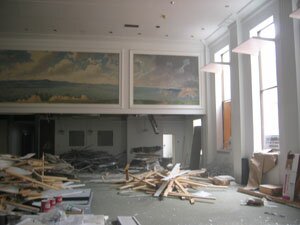ON ARCHITECTURE- Art in place: IX building grabs old bank mural
Little did architect Gate Pratt know that one of his first tasks as an architect hired by developer Oliver Kuttner to renovate the old Boxer Learning building on the Downtown Mall would involve restoring a 55-year old painting.
"We want to give it a new home," Pratt told the Hook in mid-August. He meant the 50 foot-long, 10 foot-high mural commissioned for the former Citizens Bank and Trust building in 1955. Originally Kuttner had wanted to keep the mural, but he became concerned that it might be damaged or even destroyed during the interior demolition and renovations.
In mid-August, Pratt began looking for a new home for the mural. He says the Hook story highlighting both the mural's history and Kuttner's desire to find a home for it generated a flurry of interest from professional curators, art historians, and business owners.
Now it looks as though the painting has found a home. In fact, one might say it will stay in the family.
The mural, which spans the upper wall in the lobby of the old Bank building, is divided into three sections and offers a sweeping pastoral image of the Blue Ridge Mountains, a view of Monticello from Montalto, and the City of Charlottesville beyond the tree line. The center panel was painted by H. Warren Billings in 1955; he added the panels on either side in the mid-1960s.
Although initial attempts to track down the artist were fruitless, through Jean Collier at the University of Virginia Art Museum, Pratt was able to locate the artist's son, Warren M. Billings, a professor of history at the University of New Orleans.
"I know the mural of which you speak quite well because I helped the artist, my father, hang it," Billings wrote in an e-mail to Collier. "It was one of many he painted during his career. Dad died 20 years ago at the age of 92. It's nice to hear that it still hangs in the bank."
Later, Pratt contacted the younger Billings to let him know the painting was going to be moved.
"As you perhaps have discovered," Billings wrote, offering more details about the way it was mounted to help in its removal, "the mural is painted on canvas. Dad painted it in his studio in Richmond, then rolled it up, carted it off to Charlottesville, and hung it using a high grade of wallpaper paste... I can say that it was wheat-based because I can still recall its dough-like smell.
"Once the mural was in place, Dad touched it up as necessary and blended the edges in with the surrounding wall. When everything was well dry, he gave the mural a wash of thinned buttermilk, which he said served to tone down any sharp highlights that could catch the sun."
Although Billings was no Rembrandt, and no one suggested the painting belonged in a museum, Kuttner and company believed it was worth saving.
"Lexi Bores, the project manager of the IX building, saw the story in the Hook and gave us a call," says Pratt. "And as it turns out, Oliver Kuttner's father, Ludwig, is one of the partners in the IX building. They also have a great place in their lobby for the painting."
Pratt thinks the familial connection might make the transfer easier, as the two projects will have to split the cost of the effort, which could take months to complete.
When Pratt first went looking for art conservators to manage the project, the cost estimates surprised him. "They were in the "tens of thousands," he says. Fortunately, Pratt got a visit from Scott Nolley, a conservator with Richmond-based Fine Art Conservation, who agreed to oversee the project using a local crew of artists, art students, and construction workers. Pratt says Nolley recently did a similar project in the State House in Richmond.
As Pratt describes it, the process of transferring the mural sounds a lot like surgery. First, the painting is treated with a finish and covered with thin paper to protect the paint. As the painting is gently peeled off the wall around a cardboard tube, all the glue it was attached with must be meticulously removed and the canvas cleaned. (Apparently, removing the glue is important because if there's an unforeseen delay in the project and the works are kept in storage too long, the glue can destroy the painting.)
The rolled canvas is inserted into tubes to be transferred. At the new site, the wall is prepared and the mural slowly re-glued. It's a process that can take up to 12 weeks, says Pratt. Realistically, he thinks the mural will be back on view in the IX building by next spring. "It's nice that the paintings will get a good cleaning and rebirth, and will stay within a few blocks," he adds.
Pratt, along with architects Giovanna Galfione and David Kariel, having solved the mural dilemma, are in their own artistic modes, putting together their drawings for a meeting with Kuttner in a few weeks. On a recent visit to Kariel's downtown studio, we got a look at some of his early drawings, which show the façade of the building preserved as it is, beautiful curved staircases in the lobby, a courtyard within the building, and tiered residences and gardens on the roof. Of course, Kariel admits the final product will be a collaboration between his partners, with Kuttner making the final decisions, so many more drawings will follow.
If the four of them are as concerned and careful as they have been with preserving the mural, we should be able to count on something that both preserves history and moves the Mall into the future.

This 1955 mural in the old Boxer Learning building will be moving to the IX Building in spring 2007. PHOTO BY DAVE MCNAIR#